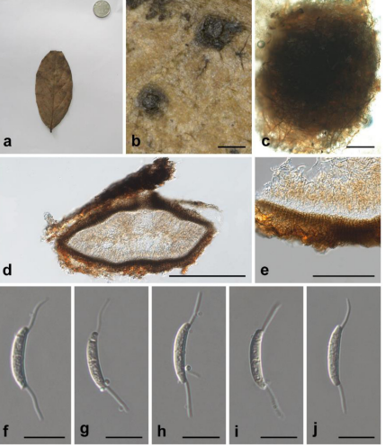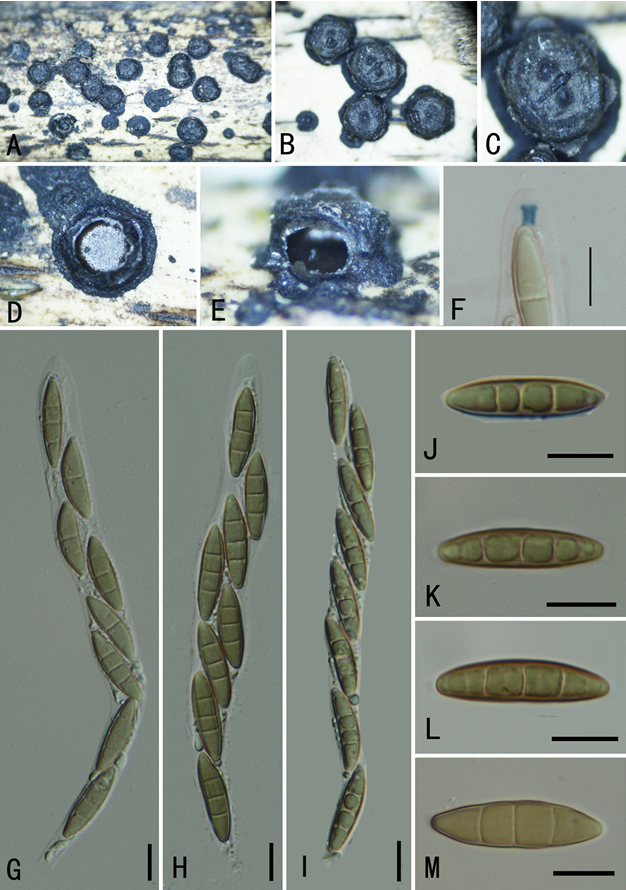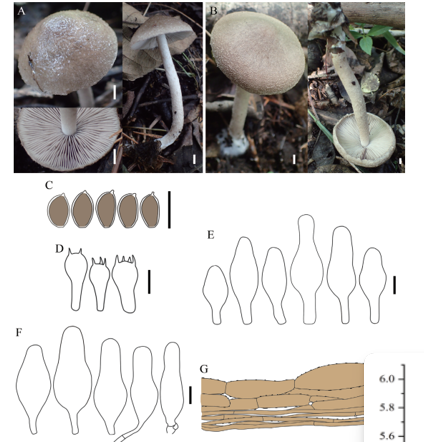Diatrypella yunnanensis Brahmanage, Thyagaraja & K.D. Hyde 2020
Index Fungorum number: IF556926; Facesoffungi number: FoF 07205
Holotype: CHINA, Yunnan Province, Kunming Forest Park, on dead and dying twigs of an unidentified plant, 30 June 2018, V. Thyagaraja, VT 01 (JZBH3380001, holotype).
Morphological description
Sexual morph Ascomata solitary and scattered, immersed, raising the substratum, or erumpent. Entostroma effuse, a faint black line between the groups sometimes present, wood hardened; a thin layer of white pulvinate fungal material sometimes present around the ascomal venter. Ascomal venter 360–440 µm high, 245–260 µm wide ( x̄ = 400 × 255 μm, n = 20), at sides 20–30 μm ( x̄ = 28 μm, n = 10), subglobose to broadly ellipsoidal, ostiolate, periphysate, comprising an outer layer of centre of the group. Peridium 45–55 μm wide ( x̄ = 52 μm, n = 10), in transverse section with an outer, layer of small, thick-walled, melanized, rounded cells, and an inner layer of hyaline, elongate cells in textura angularis. Paraphyses up to 4–7 µm wide, hyaline, septate, deliquescent. Asci 105–210 × 15–30 μm ( x̄ = 170 × 28 μm, n = 20), polysporous, clavate, truncate, pedicellate, with a refractive subapical, J-, ring at the base of an invagination of the ascus apex. Ascospores 18–22 × 3–4 μm ( x̄ = 19 × 3 μm, n = 20), allantoid, slightly curved, pale yellow to pale brown. Asexual morph Undetermined.
Habitat: unidentified dead wood.
Distribution:China.
GenBank Accession: I TS: M N 6 5 3 0 0 8 ;TUB2 :MN887112.
Notes: Diatrypella yunnanensis is phylogenetically related to D. pulvinata Nitschke and D. favacea (Fr.) Ces. & De Not. and grouped within Diatrypella sensu lato (Fig. 149). Diatrypella yunnanensis can be easily distinguished from D. favacea and D. pulvinata by relatively bigger ascomta, asci and ascospores (Table3). When comparing the ITS base pair differences of D. yunnanensis with D. favacea and D. pulvinata, there were 3.4% (18 bp out of 527 bp without gaps) and 1.3% (7 bp out of 527 bp without gaps), respectively. TUB2 base pair differences between D. yunnanensis and D. pulvinata are 5.3% (23 bp out of 435 bp without gaps). There are no TUB2 sequences generated from
D. favacea. We could not obtain a culture for this species as the ascospores did not get germinate in any media used.
Reference: Kevin D. Hyde1,5,8,22 · Yang Dong2,3 · Rungtiwa Phookamsak1,5,6,7 et al.
Diatrypella yunnanensis (JZBH3380001, holotype). a Appearance of stromata on host. b, c Horizontal section through stroma. d Paraphyses. e, f Asci. g Ascospores. Scale bars: d, e = 100 μm, f = 50 μm, g = 20 μm









